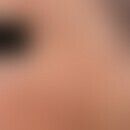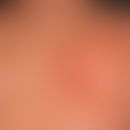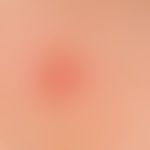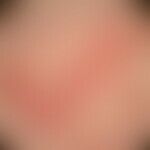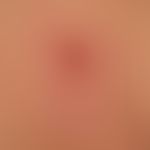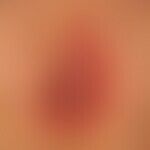Synonym(s)
HistoryThis section has been translated automatically.
DefinitionThis section has been translated automatically.
Heterogeneous group of fibroepithelial malignant tumors of the skin, which grow locally infiltrating and destructive, metastasize extremely rarely and often show morphological analogies to adnexal structures (evidence of stem cell formations in basal cell carcinomas as well as in embryonic hair germs). Basal cell carcinoma is the most common (semi-)malignant skin tumor in humans, and its incidence and prevalence have been increasing worldwide in recent years. For Caucasians, the current lifetime risk of developing basal cell carcinoma is estimated at 30%. In Germany, between 1.0 and 2.0 million new diagnoses are made each year.
You might also be interested in
ClassificationThis section has been translated automatically.
I. Clinical classification:
- Nodular basal cell carcinoma (>50% of cases)
- Superficial bas al cell carcinoma (15% of cases)
- Sclerodermiform bas al cell carcinoma (about 25% of cases)
- Pigmented basal cell car cinoma (<5% of cases)
-
Ulcerated basal cell carcinoma
- Ulcus rodens (superficial ulcerated basal cell carcinoma)
- Ulcus terebrans (destructive basal cell carcinoma <1% of cases)
Special forms:
- Basal cell carcinomatosis / basaliomatosis: Tumor-associated genodermatoses with basal cell carcinomas
- Non-syndromal multiple basal cell carcinomas (also linear form); see below. Nevoid basal cell carcinoma syndrome (Gorlin-Goltz syndrome)
II. Histologic classification:(
- Keratotic basal cell carcinoma
- Solid basal cell carcinoma
- Dimorphic basal cell carcinoma
-
Superficial basal cell carcinoma
- Special form: Premalignant fibroepithelioma (Pinkus tumor)
- Sclerodermiform basal cell carcinoma.
Special forms:
- Fibroepithelial basal cell carcinoma
- Metatypical basal cell carcinoma (metatypical epithelioma of the "mixed or intermediaire" type)
- Cystic basal cell carcinoma.
Occurrence/EpidemiologyThis section has been translated automatically.
Dear Altmeyers team,
the link to Gorlin-Goltz syndrome here is not correct. Unfortunately, you are redirected to Goltz-Gorlin syndrome (focal dermal hypoplasia), which has nothing to do with BCCs. Instead, the link to "Nevoid basal cell carcinoma syndrome" must be inserted. Unfortunately, both were coined by Goltz and Gorlin, hence the confusing naming.
Best regards!
Tilman Erler
________________________________________________________
Most common carcinoma of the skin among the Caucasian population whose predisposition is determined by individual patient characteristics such as light skin type, advanced age, immunocompetence and genetic syndromes (e.g. Gorlin-Goltz syndrome, xeroderma pigmentosum, Rombo syndrome).
Incidence rates are missing for most European countries. In Germany, the incidence is approx. 70-200/100,000 inhabitants/year. Known European data indicate the highest incidences in Wales (112/100,000 inhabitants/year) and the lowest in Finland (49/100,000 inhabitants/year). For Australia, the incidence is estimated at 800/100,000.
Men and women are equally affected.
People with actinic cheilitis and solar lentigines have a higher risk of developing basal cell carcinoma.
Only very rarely does metastasis occur (less than 1:1000). In North America, the incidence in the population < 40 years is higher in women than in men.
EtiopathogenesisThis section has been translated automatically.
According to current knowledge, basal cell carcinoma originates from epidermal stem cells from the hair follicle bulge or from undifferentiated cells of the outer root sheath, see also illustrations.
UV radiation: multiplicative factors (e.g. anamnestic sunburns, cumulative sun exposure, intermittent high exposure peaks) play a role in the development.
Genetic factors: somatic mutations of the p53 tumor suppressor gene, various mutations in the so-called hedgehog gene. Mutations in the so-called Hedgehog signaling pathway - PTCH1; SMO - see nevoid basal cell carcinoma syndrome; also frequent occurrence in xeroderma pigmentosum and albinism.
Other triggering factors in the development of basal cell carcinomas:
- Light-skinnedness
- Carcinogenic substances, particularly arsenic in earlier times
- Long-term immunosuppressive therapy
Chronic skin damage, e.g. due to infections or physical stimuli, trichotillo basal cell carcinoma, radiodermatitis chronica.
Prostaglandins: Animal experiments have shown a massive increase in prostaglandin synthesis in UV-induced murine skin tumors. Selective inhibitors of prostaglandin synthesis reduce the development of basal cell carcinomas.
ManifestationThis section has been translated automatically.
Preferably occurring in fair-skinned people (skin types I and II), very rarely in dark-skinned people.
In 80% of cases in the head and neck area. Age peak 6th to 8th decade of life. A tendency toward younger age of manifestation is evident. Men and women are equally affected.
In addition, occurrence (as basal cell carcinomatosis of the skin) in the context of hereditary syndromes (then also possible in young patients), especially in:
LocalizationThis section has been translated automatically.
Basically: Localization only on skin areas with formation of hair follicles. No primary manifestation on mucous membranes and semi-mucous membranes.
Head and neck area (about 80%: nose, inner corner of the eye, zygomatic bone, forehead, rarely lower third of the face, followed by capillitium and ears - also retroauricular).
Stem (15-20%) and extremities(superficial basal cell carcinoma) are rarer localizations.
Genital and perianal localisations are possible, but very rare.
ClinicThis section has been translated automatically.
Mostly skin-colored or red or red-brown nodules, plaques, lumps or ulcers. The clinical aspect depends on the age of the lesions (size, surface, color), the location and the type of basal cell carcinoma present (see different clinical variants).
- Marginal accentuation: Typical for basal cell carcinomas is the marginal accentuation (this applies to superficial basal cell carcinomas) of the lesions in the form of glassy, skin-colored or white-gray, often "pearl-like" nodules. This phenomenon can be emphasized by tightening the surrounding skin.
- Shiny surface: an atrophic, shiny surface is mainly found in protuberant plaques or nodules
- Absence of follicular structures: the local skin follicles are destroyed due to the destructive growth of the tumor.
- Bizarre tumor vessels: The appearance of atypical, usually bizarrely configured tumor vessels, which can be visualized particularly well under reflected light microscopy, is alsodiagnosticallyvaluable.
Under reflected light microscopy, tortuous vessels, sometimes also white lines, pink structureless area, possibly streaky pigmentation are impressive. In the case of intratumoral calcification, aggregated yellowish globules, so-called May = multiple aggregated yellow-white globules, are observed
ImagingThis section has been translated automatically.
Imaging is usually not required for basal cell carcinoma.
Further diagnostic imaging is recommended in the following cases:
- Locally-advanced basal cell carcinoma (lfBZK): If bone infiltration is suspected, computed tomography and/or contrast-enhanced magnetic resonance imaging should be performed.
- Periorbital basal cell carcinoma: If orbital infiltration is suspected, computed tomography of the orbit and contrast-enhanced magnetic resonance imaging should be performed.
- Perineural growth: If perineural growth is suspected, MRI with fat-saturated high-resolution contrast-enhanced T1w sequences should be performed.
- Metastasis: Ifmetastasis is suspected, further diagnostic imaging should be performed. 18F-FDG PET/CT and/or CT may be considered for this purpose.
- Basal cell carcinoma syndrome: If basal cell carcinoma syndrome is suspected, further imaging diagnostics should be performed to exclude other associated malignancies and malformations. For this purpose, according to the current guidelines, a dermatological whole body examination, MRI of the skull, echocardiography, X-ray of the spine and dental panoramic radiography should be performed. In female patients, a gynecological pelvic ultrasound should also be performed.
HistologyThis section has been translated automatically.
- Mostly solid epithelial strands of cells with little cytoplasm and roundish to oval dark nuclei, which form palisade-like at the edges. Cystic, adenoid or trichoid forms are possible without these histological varieties being clinically specific among the individual basal cell carcinoma types. A cell-rich tumor stroma is characteristic.
- The tumor cell clusters show positive results when stained with the antibody against BerEp4, the "epithelial cell adhesion molecule" EpCAM. This antibody is not expressed by squamous cell carcinomas and thus represents an important differentiation possibility between the two tumor entities.
- In contrast to trichoepithelioma, basal cell carcinomas show PHLDA1 (pleckstrin homology-like domain family A member 1) negativity (see also premalignant fibroepithelioma).
- Laser scanning microscopy: elongated, monomorphic cell nuclei, polarization of these cells along an axis, pronounced inflammatory infiltrate, proliferated as well as dilated vessels and loss of the epidermal honeycomb structure, islets of tumor cells with peripheral palisade position in the dermis delimited by a dark slit = optical slit, see figure.
DiagnosisThis section has been translated automatically.
Diagnosis is usually made by biopsy and conventional histology in cases of clinical suspicion. The certainty of clinical diagnosis is routinely supplemented by noninvasive dermoscopy. Furthermore, noninvasive laser scanning microscopy or noninvasive optical coherence tomography (OCT) can enhance clinical diagnosis.
External therapyThis section has been translated automatically.
For the topical therapy of basal cell carcinoma, 3 therapeutic procedures are approved:
- 5-fluorouracil (only for superficial basal cell carcinoma): Local chemotherapeutic treatment. 5-fluorouracil ointment (e.g. Efudix ointment) is applied to the basal cell carcinoma twice a day for about 6 weeks. Due to strong external irritation reactions as well as the long duration of treatment (sometimes up to 3 months, Cave! patient compliance), other procedures are usually preferable. For multiple basal cell carcinoma of the trunk skin, local chemotherapy in combination with curettage may be a sensible method.
- Imiquimod: After histological confirmation local therapy with Imiquimod (Aldara 5%). Treatment is given once a day for 5 days a week for a total of 6 weeks. Numerous studies prove the good healing (80%). Imiquimod is approved for superficial basal cell carcinomas under 7.25 cm². The topical treatment is a suitable alternative to surgical resection in superficial basal cell carcinoma, especially in multiple trunk skin basal cell carcinoma and induces an acute inflammatory reaction in the affected area by activating the Toll-like receptors 7 and 8. This inflammatory reaction, which is induced by the immune system, leads to an activation of the body's own defence and consequently to a healing of the original skin change. Pronounced irritation of the treated areas is an expected side effect.
- Photodynamic therapy (PDT): Therapeutic procedure which causes a sensitization of basal cell carcinoma cells by means of the affinity of externally or internally applied photosensitizers (ALA = 5-aminolevulinic acid, or the ester MAL = methyl-aminolevulinic acid). Subsequent irradiation leads to the destruction of the tumour without affecting the surrounding tissue. A larger comparative study (n=601 Pat) between MAL-PDT and Imiquimod showed a therapeutic benefit for the Imiquimod group (Roozeboom 2016).
Radiation therapyThis section has been translated automatically.
Basal cell carcinomas are very sensitive to radiation. Radiation therapy has approximately comparable healing prospects to surgical treatment, but is rarely used because of the often better cosmetic results of microsurgical procedures. The indication for radiation treatment exists mainly in cases of primary inoperability, postoperative microscopic (R1-resection) or macroscopic residual tumor (R2-resection). A further indication exists if there is a recurrence postoperatively and a sano resection is unlikely. The surrounding tissue as well as risk organs, especially eyes, including eyelashes and tear glands or ear cartilage are protected by lead masks. Soft X-rays or fast electrons are used.
- Soft X-rays: Fractionated irradiation with ED of 3-5 Gy at GD of 50-60 Gy 3-6 times/week. The GHWT (tissue half depth) should correspond to the depth invasion of the tumor, generally 6-12 mm. The radiation field should be 0.5-0.7 cm larger than the tumor. If after reaching the GD no complete tumor regression or erosion is visible over the entire radiation field, the radiation is continued in intervals of several days. At least an erosion extending over the entire tumour (erosive reaction) is to be aimed at in order to complete the treatment.
Internal therapyThis section has been translated automatically.
It could be shown that the hedgehog signalling pathway is of crucial importance for the pathogenesis of basal cell carcinomas. Most sporadic basal cell carcinomas have mutations in this signalling pathway. Systemic approaches in the therapy of basal cell carcinoma are inhibitors of the Hedghog signalling pathway that bind to SMO and thus prevent signal transduction.
With Vismodegib and Sonidegib, two specific inhibitors of SMO are available for the treatment of inoperable or metastasized basal cell carcinoma. The results are encouraging.
Experimental: It could be shown that the azole antifungal drug itraconazole has an inhibitory effect on the SHH signaling pathway. The mechanism of action via SMO binding sites is different from the mode of action of vismodegib and sonidegib. A first phase II study (n=19 pat.) showed some efficacy (200mg 2x/day).
Operative therapieThis section has been translated automatically.
Remark: Different local infiltration patterns can be expected in different entities of basal cell carcinoma. Especially in sclerodermiform basal cell carcinoma an asymmetric distributed growth is to be expected, often subclinical narrow spindle-like spurs are found in the surrounding tissue. This growth pattern must be taken into account when planning a surgical intervention.
Excision: Most common therapeutic procedure for uncomplicated basal cell carcinoma. This usually requires (depending on the findings) a two-stage operation with temporary defect coverage (e.g. Syspuderm or Epigard). Safety margin is usually 0.5 cm, in primary nodular basal cell carcinoma 0.1-0.6 cm are sufficient, in recurrences as well as in unclear clinical demarcation e.g. in sclerodermifom basal cell carcinoma the complete visualization of the three-dimensional cut margins is required.
Since basal cell carcinomas are frequently localized in the head and neck region (e.g., nose), the safety distance must be adapted to the given circumstances. Attention must be paid to optimal reconstruction. For small, favorably localized basal cell carcinomas, oval or spindle excision in the "relaxed-skin-tension-lines" is recommended. Histologic margin control is obligatory, a post excision according to the histologic findings and the anatomical conditions. The intraoperative frozen section is often insufficient as a margin control, as it only allows a punctual statement.
Micrographically controlled surgery: Micrographically controlled surgery is the safest and most gentle surgical procedure. The serial histological 3D preparation allows a safe and comprehensive statement about the spread of the tumor to the side and depth. With this technique, the local recurrence rate is reported to be < 1% for solid basal cell carcinoma. For sclerodermiform basal cell carcinomas, the local recurrence rate is < 2%. Thus, micrographically controlled surgery is clearly superior to bread loaf histology for basal cell carcinomas.
Flat ablation: For basal cell carcinomas of the cheek and nose, flat ablation with 3D histology assured R0 resection and secondary wound healing, is a cosmetically good alternative to large (displacement) plastic surgery for the primary procedure.
Cryosurgery: Multiple freezing with intermediate thawing phases at temperatures of -30 °C at the tumor base (temperature measurements with temperature probe). Alternative: 15 seconds at -180 °C, two cycles. A few days after cold application, necrosis with blister formation occurs in the treated area. The patient should be made aware of the regularly occurring edema. Sterile wound dressing (e.g. Oleo-Tuell or Varihesive extra thin). Tumors in the nasolabial fold area are unsuitable for cryosurgical procedures because of the particularly high risk of recurrence in these areas. Eyelid basal cell carcinomas should only be treated in exceptional cases and by a surgeon experienced in cryosurgery.
Laser: In defocused application for superficial vaporization with single pulse lengths of 0.1-0.2 sec, spot size 0.2-0.4 cm, 5-10 watts. In focused application, theCO2 laser is used as a "light scalpel". The use of laser does not offer any reliable advantage over conventional procedures. As a so-called blind procedure, a high recurrence rate is to be expected.
| Depth of cut | shallow ablation, epidermis, dermis, subcutis (depending on size) |
| Safety distance | 0.1 - 0.6 cm |
ProphylaxisThis section has been translated automatically.
UV avoidance: avoidance of strong sun exposure, use of high SPFs, avoidance of photosensitizing or phototoxic drugs such as hydrochlorothiazide.
Retinoid therapy: Acitretin (Neotigason) can be used as a preventive long-term therapy for basal cell carcinomatosis, basal cell nevus syndrome or xeroderma pigmentosum (0.5 to max. 1 mg/kg bw/day). To prevent the occurrence of basal cell carcinoma, higher doses must be used than in other long-term applications. Caution. Women of childbearing age! Children (bone growth)!
NaturopathyThis section has been translated automatically.
Order therapy: Avoid UV
Phytotherapy: betulin, green tea, garden spurge
Vitamin B3: For nicotinamide (Vit B3), a phase III study in 386 patients has been completed to investigate its preventive effect on basal cell carcinoma (2x500mg Vit B3). The rate of new cases could be reduced by 20%. The chemopreventive effect lasted only as long as the preparation was administered.
TablesThis section has been translated automatically.
Therapeutic methods and their indication
Procedure |
Indication |
Advantage |
Disadvantage |
Excision |
Solid basal cell carcinomas in unproblematic localization, clear clinical limitability. |
Simple and fast procedure, histological edge control, relatively low recurrence rate |
Difficult in basal cell carcinomas with unclear boundaries and a large depth extension. Compared to MKC higher risk of recurrence. |
MKC - Micrographically Controlled Surgery |
Recurrence of basal cell carcinoma, extensive basal cell carcinoma of the face, unclear clinical delimitation, scleroderma basal cell carcinoma, basal cell carcinoma in special localisation (corner of the eye, nasal bridge, auricle). |
Reliable marginal incision control, lowest recurrence rate |
Elaborate, multi-stage procedure. |
Curettage and electrodesiccation1 |
Superficial basal cell carcinomas of the trunk and extremities, basaliomatoses (e.g. basal cell nevus syndrome), toxic induced basal cell carcinomas (e.g. arsenic intoxications), especially in older patients. |
Quick |
Edge cut control not possible. Relatively poor cosmetic results, especially after electrodesiccation, tendency to hypertrophic scarring. |
Cryosurgery1 |
Flat, small basal cell carcinomas whose tumor parenchyma does not exceed the middle corium. |
Non-invasive, relatively good cosmetic result |
Edge cut control not possible. Extensive experience with the method is important. Relatively high recurrence rate, frequent depigmentation. |
CO2 laser focused (light scalpel) |
Superficial basal cell carcinomas |
Low risk of bleeding, clear operating field |
Tendency to scar and keloid formation. |
CO2- Laser1 defocused |
Superficial basal cell carcinomas |
Non-invasive |
Edge cut control not possible. The depth effect of the therapy is difficult to measure. |
Radiotherapy1 |
Only in patients of advanced age, medium-sized nodular basal cell carcinomas, pigmented basal cell carcinomas, trunk skin basal cell carcinomas. Suitable are localisations in the face, also on eyelids, eye corners, nose, nasolabial fold, auricle and lips. Not over ear cartilage, bony base, back of the hand. |
Non-invasive, recurrence rate depends on basal cell carcinoma type (solid approx. 5%, sclerodermiform > 30%) |
Edge cut control not possible. Induction of new tumours, X-ray dermis, danger of poorly healing necroses, especially over cartilage and bony base. |
Interferons1 |
Superficial and small nodular basal cell carcinomas |
Non-invasive |
Edge cut control not possible. Application is not recommended because it is expensive and unsafe. |
5-fluorouracil1 |
Superficial basal cell carcinomas |
Non-invasive |
Edge cut control not possible. Considerable local side effects with inflammations, pigment shifts, scarring are possible. |
Prophylaxis: Retinoid therapy |
Absolute indication: Xeroderma pigmentosum, basal cell nevus syndrome, condition after prolonged use of arsenic. |
Prophylaxis |
Side effects of retinoid therapy: teratogenicity (up to 24 months after discontinuation), dryness of the mucous membranes, cheilitis, hair loss. Monitor bone growth in children! |
Relative indication: multiple basal cell carcinomas in immunocompromised patients (condition after organ transplantation), multiple basal cell carcinomas after severe light damage to the skin or arsenic intoxication. |
AftercareThis section has been translated automatically.
Note(s)This section has been translated automatically.
Metatypical basal cell carcinoma (metatypical epithelioma of the "mixte or intermediaire" type): This is a rare variant that histologically reveals morphologic aspects of both basal cell carcinoma and squamous cell carcinoma. Such peculiarities are particularly found in older people with lesions that have been present for a long time. This type shows more rapid and aggressive growth.
Recent studies indicate a reduction in the incidence of basal cell carcinoma during therapy with metformin.
LiteratureThis section has been translated automatically.
- Alter M et al (2015) Current diagnosis and treatment of basal cell carcinoma. JDDG 13: 862-876
- Bivens MM et al (2006) Nonmelanoma skin cancer: is the incidence really increasing among patients younger than 40? A reexamination using 25 years of U.S. outpatient data. Dermatol Surg 32: 1473-1479
- Breuninger H et al. (1992) Quantitative analysis of recurrence or spontaneous regression of basal cell carcinoma sections left in situ. Dermatologist 43: 561-56
- Breuninger H (2015) Safety margins in malignant skin tumors. Derm 21: 203-211
- Chen AC et al.(2015) A phase 3 randomized trial of nicotinamide for skin cancer chemoprevention. N Engl J Med 373:1618-1626.
- Dummer R et al.(2016) The 12-month analysis from Basal Cell Carcinoma Outcomes with LDE225 Treatment (BOLT): A phase II, randomized, double-blind study of sonidegib in patients with advanced basal cell carcinoma. J Am Acad Dermatol 75:113-125.
- Geisse J et al (2004) Imiquimod 5% cream for the treatment of superficial basal cell carcinoma: results from two phase III, randomized, vehicle-controlled studies. J Am Acad Dermatol 50: 722-733
- Goldgeier M et al (2003) Noninvasive imaging, treatment, and microscopic confirmation of clearance of basal cell carcinoma. Dermatol Surg 29: 205-210
- Heppt M et al (2016) What's new in basal cell carcinoma? Dermatol Surg 67: 876-883
- Herzinger T et al (2003) Basal cell carcinoma of the toenail unit. J Am Acad Dermatol 48: 277-278.
- Joshi A et al (2000) Basal cell carcinoma arising in a localized linear verrucous epidermal naevus. Acta Derm Venereol 80: 227-228
- Kim DJ et al (2014) Open-label, exploratory phase II trial of oral itraconazole for the treatment of basal cell carcinoma. J Clin Oncol 32:745-751.
- Krompecher E (1900) The glandular surface cancer (Ca epitheliale adenoides). Beitr Path Anat 28: 1-41.
- Kumar P (2002) Incomplete excision of basal cell carcinoma: a prospective multicentre audit. Br J Plast Surg 55: 616-622.
- Lobeck A et al (2017) Review of the dermatosurgical patient population at a skin tumor center in Germany. Dermatologist 68: 377-384
- Mieczko A et al (2011) BerEP4-negative basal cell carcinoma of the palm: case report and literature review. JDDG 9:140-143
- Oster-Schmidt C, Altmeyer P, Stucker M (2002) Basal cell carcinoma of the foot. Is the pedoscope a risk factor? Dermatologist 53: 819-821
- Roozeboom MH et al (2016) Three-Year Follow-Up Results of Photodynamic Therapy vs Imiquimod vs Fluorouracil for Treatment of Superficial Basal Cell Carcinoma: A Single-Blind, Noninferiority, Randomized Controlled Trial. J Invest Dermatol 136:1568-1574.
- Sterry W et al (2002) Imiquimod 5% cream for the treatment of superficial and nodular basal cell carcinoma: randomized studies comparing low-frequency dosing with and without occlusion. Br J Dermatol 147: 1227-1236
- Stücker M et al (2002) In vivo differentiation of pigmented skin tumors with laser Doppler perfusion imaging. Dermatologist 53: 244-249
- Van Hoff et al (2009) Inhibition of the hedgehog pathway in advanced basal-cell carcinoma. N Engl J Med 361: 1164-1172.
- Walther U et al (2004) Risk and protective factors for sporadic basal cell carcinoma: results of a two-center case-control study in southern germany. Clinical actinic elastosis may be a potective factor. Br J Dermatol 151: 170-178.
- Wang LE et al (2005) In vitro sensitivity to ultraviolet B light and skin cancer risk: a case-control analysis. J Natl Cancer Inst 97: 1822-1831
- Navarrete-Dechent C et al (2020) Association of Multiple Aggregated Yellow-White Globules With Nonpigmented Basal Cell Carcinoma. JAMA Dermatol. 156:882-890
- Adalsteinsson JA et al. (2021) Metformin is associated with decreased risk of basal cell carcinoma: A whole-population case-control study from Iceland. J Am Acad Dermatol. 85: 56-61
Incoming links (127)
Adenoma sebaceum; Albinism oculocutaneous tyrosinase-negative; Albinism oculocutaneous tyrosinase-positive; Angiosarcoma epitheloides; Bap1 Tumor Predisposition Syndrome ; Basal cell carcinoma; Basal cell carcinoma; Basal cell carcinoma cystic; Basal cell carcinoma destructive; Basal cell carcinoma dimorphic; ... Show allOutgoing links (47)
Albinism oculocutaneous (overview); Albinism (overview); Arsenic intoxication; Basal cell carcinoma cystic; Basal cell carcinoma destructive; Basal cell carcinoma dimorphic; Basal cell carcinoma keratotic; Basal cell carcinoma nodular; Basal cell carcinoma nodular; Basal cell carcinoma pigmented; ... Show allDisclaimer
Please ask your physician for a reliable diagnosis. This website is only meant as a reference.

